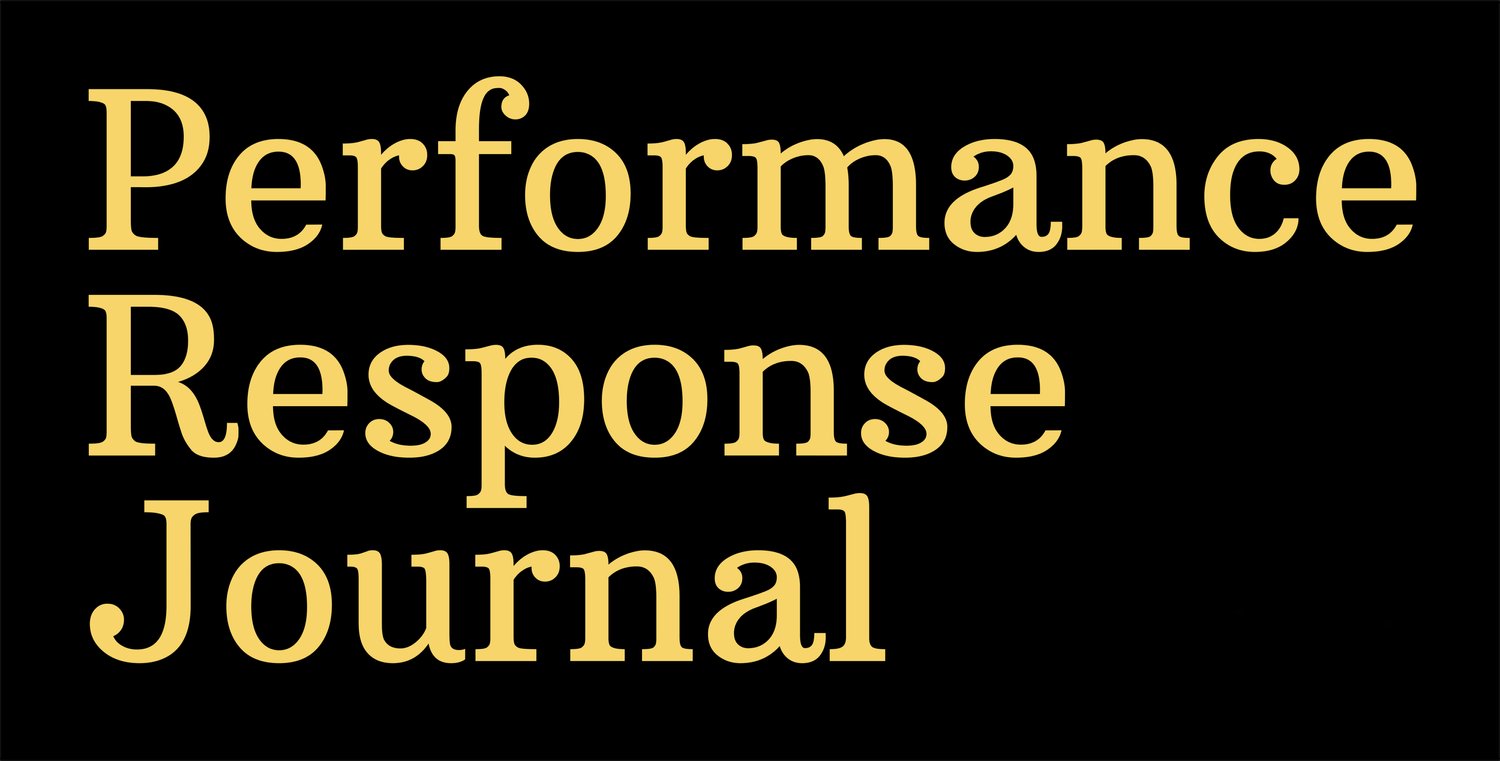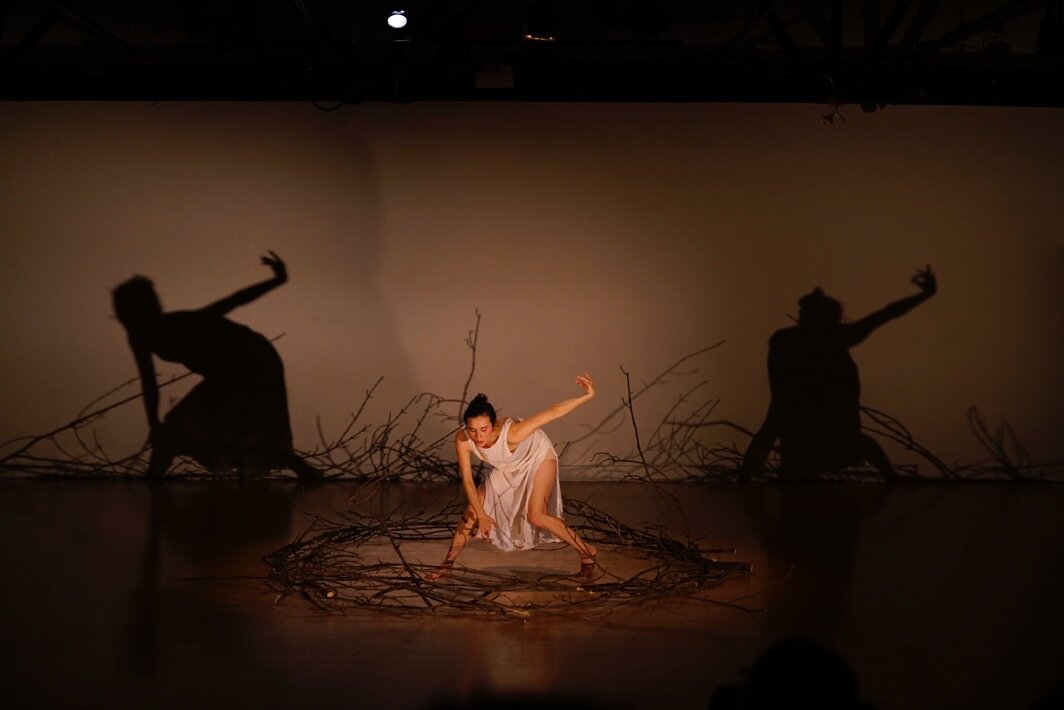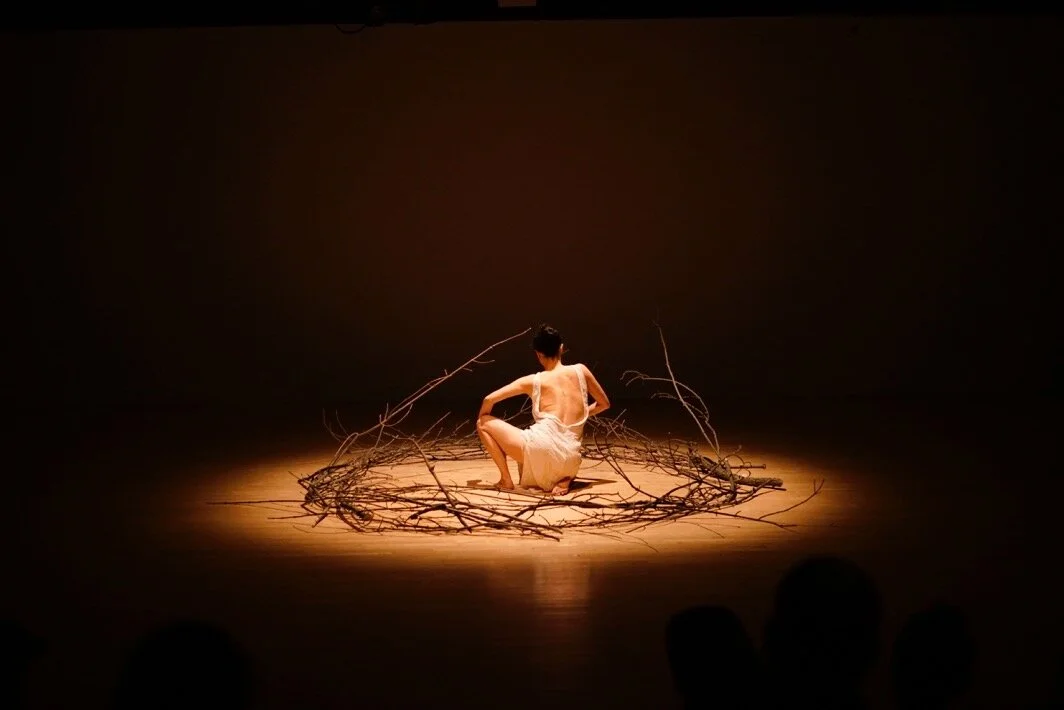Out/In aka: An Interview with Mitsu Salmon by Jane Jerardi
Jane Jerardi interviews Mitsu Salmon on Out/In aka
from Links Hall performance LinkUP February 2017
images by: Tingyu Huang
*********************
In late February 2017, Mitsu Salmon shared her newest work – Out/In aka – at the close of her LinkUP residency at Links Hall alongside Anna Martine Whitehead. I caught up with both of them to talk about their process in and out of the studio. What follows here is my conversation with Mitsu over email as she completes a residency in Taiwan at the Tsung Yeh artist village.
Jane Jerardi: I know that for some of the process, you were thinking a lot about storytelling – how we hear about our lineage and how we tell those stories. How do we create stories for the stage without necessarily becoming (overly?) literal. There are so many details to the work – from the tree branches to the videos of a train ride in Japan, to the hand-made red ‘tiles’ that the homemade red-velvet cake is served on for audiences. What were some of the details of the story that were most important to you or what became most important for you in making the work?
Mitsu Salmon: Narrative is important in my work, but I am interested in how stories, images, and feeling can be conveyed both with and without words. I try to have elements of ambiguity in the work so the audience can place their own stories and associations on to what is happening. But some aspects of the story I aim to come through clearly, so I say them in multiple ways.
The red roof is significant. First, it enabled my grandfather to identify where my grandmother lived in Fukuoka. My grandmother married a Japanese-American soldier, my grandfather; moving to the states greatly altered her life. The roof symbolizes the western influence – her family had the only western style house in the neighborhood. But also, because her house was made from bricks and concrete, when her city (Fukuoka) was bombed, her house became a place of shelter for others. And yet, also because it was a Western style house, the US army took over and lived in her home during the occupation.
The symbol of the home is central – its creation, transformation, and loss. The branches build a nest at the start of the piece. But, once the helicopters come, the nest slowly comes undone. The train is connected to the movement and westernization happening after the war and also to my grandmother’s travel.
Jane: How did personal stories become translated into images, movement, song? How did this play out in the studio? Did you have a particular method for working?
Mitsu: The process began by myself. I would take time just moving freely in the studio and then journal. I would move for 15 minutes and write for 15 minutes – that is often how I start work. From there, certain ideas and images emerged.
I also let research influence my work. For example, I’ve been reading about WWII Japan, mostly from the book Embracing Defeat as well as talking with family. I would bring images, objects, and text to rehearsal, which I would explore alone or with Simon (collaborating sound artist).
I showed some of the work to my mentor Nora Taylor who suggested I try to tell the stories in multiple ways such as song and movement, in addition to visual elements. I then tried all the stories various ways and discovered that some mediums better expressed certain stories.
Jane: I was reminded quite a lot of how when we are told family stories we really don’t know a lot of the specific details, but certain details stick out because they’re always included when the story is told – like the ‘red roof’ of your grandmother’s family house – almost in the retelling of these stories the details become the way the story becomes transmitted. You also do that with the audience. How did you come to decide to have the audience loop and repeat parts of the story?
Mitsu: I wanted the audience to take in the story and be active in absorbing it and not just be passive observers. I served cake both to have the audience literally take in the story, but also to be distracted – mimicking how I often am with my family, where I only get some of the stories. With the looping, yes, parts of the family stories stay for me, and others don’t. The looping was also connected for me with my grandmother’s Alzheimers. Conversations would repeat and repeat – in that repetition, the stories and questions sunk further, but also seemed absurd and poetic. The looping also gave the stories a cyclical quality. What happened in the past is still happening.
Jane: You shift from this formal – really beautiful, picturesque images of the stage space – to breaking the fourth wall and informally speaking to the audience, so seamlessly. These are two ‘states’ that I see you using in your work – but this was the first time I saw you move back and forth so seamlessly. How did you decide which ‘states’ to use for different aspects of the story?
Mitsu: The two states – one is just talking to the audience and telling them the story in a very straightforward way, but the other is an image connected to the story. I wanted there to be an aspect which felt like a puzzle where images are introduced, but I also wanted to supply a map, talking directly to the audience, so that there is a certain direction. I am inspired by work that breaks the fourth wall, such in that of Karen Finley and Stacy Makishi – it feels so refreshing. But, I also love internal work that makes you come to it. I tried within this piece to balance the going back of the internal to external.
Jane: Some of the images were so specific – can you talk a little bit about some of the images – your bare back for an example, or the branches and where they came from? And the videos that are projected (older historic footage? and then more contemporary footage of the train)?
Mitsu: In Japanese culture, there is a saying: “reading your father’s back.” It means without your family saying anything at all, you understand their feeling from their back. I wanted to see if my family and I could express something to the audience just through the back.
The videos are old footage of trains in the 1940s in Japan, and the contemporary footage is that of train rides in the Japanese countryside.
Jane: How did you work with the sound composer/collaborator?
Mitsu: Simon Briggs and I would meet once a week and talk about ideas and then do multiple improvisations with those ideas. Some example of scores: susing field recording of the countryside, certain atmosphere, or sound qualities like wood. We then threw some out and the ones we kept, we kept refining. Simon and I had a very similar sense, and through having a consistent practice, we began to think about things the same way. I would introduce an idea and he would often be thinking the same thing and vice versa.
Mitsu Salmon has been in Taiwan at a residency at Tsung Yeh artist village in collaboration with Milad Mozari: “We are creating a site specific performance drawing from my great grandfather’s research on Taiwanese plants during the Japanese occupation as well as the architecture and history of the space.” They have been keeping a blog [https://formosanwood.wordpress.com/] about their experience and research.
********************
Jane Jerardi is a Guest Editor for PRJ.



